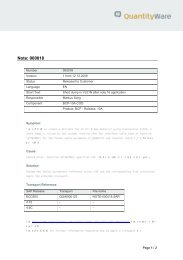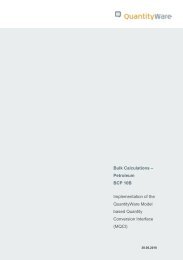QuantityWare - ASTM D1250-04_ASTM_D1250-80 comparison
QuantityWare - ASTM D1250-04_ASTM_D1250-80 comparison
QuantityWare - ASTM D1250-04_ASTM_D1250-80 comparison
- No tags were found...
Create successful ePaper yourself
Turn your PDF publications into a flip-book with our unique Google optimized e-Paper software.
5.3. Result analysis and business implications - overviewIn the following chapters our results are presented as an overview, based on our detailedresults. For each table group, first for the odd, then the even numbered tables. We then discussthe business implications per table based on our business impact decision matrix defined inAnnex C. In this summary analysis, we evaluate the percentage of differences within the <strong>ASTM</strong><strong>D1250</strong>-<strong>80</strong> ranges, found for two grid categories:The 19<strong>80</strong> grid category where input measurement data is rounded according to <strong>ASTM</strong><strong>D1250</strong>-<strong>80</strong>.The 20<strong>04</strong> grid category, where input measurement data is rounded according to <strong>ASTM</strong><strong>D1250</strong>-<strong>04</strong>. Note that the percentage values are rounded to 0,1%.For odd tables, we present the differences‟ results in base densities, which we observed withour <strong>comparison</strong> calculations.For even tables, we present the differences‟ results in volume correction factors (rounded to fiveand four decimals), which we observed with our <strong>comparison</strong> calculations.Based on the known input data rounding differences between <strong>ASTM</strong> <strong>D1250</strong>-<strong>80</strong> and<strong>ASTM</strong> <strong>D1250</strong>-<strong>04</strong> implementations for certain tables, we expect a large % value ofdifferences for these tables, typically <strong>80</strong> %.Since <strong>ASTM</strong> <strong>D1250</strong>-<strong>80</strong> provides a volume correction factor for temperature valuesbelow the base temperature (of the format 1.XXXX (four decimals only), we expect foreven tables, when considering temperature values below the base temperature, a large% value of differences, typically 90 %, since we assume to the fifth digit is evenlydistributed (either 0, 1, 2, 3, 4,…9) throughout the calculation results for such largenumbers of calculations.Thus, differences caused by other changes described in chapter 3 will be “hidden” by thesedominating effects.Finally, the % difference value can be interpreted as a probability to encounter a relevantdifference between your legacy <strong>ASTM</strong> <strong>D1250</strong>-<strong>80</strong> implementation and your new <strong>ASTM</strong> <strong>D1250</strong>-<strong>04</strong> implementation.Comparison of <strong>ASTM</strong> <strong>D1250</strong>-<strong>04</strong> and <strong>ASTM</strong> <strong>D1250</strong>-<strong>80</strong> 25/49










![Petroleum ASTM D1250-80 SP09 [276.9 KByte] - QuantityWare](https://img.yumpu.com/48083876/1/184x260/petroleum-astm-d1250-80-sp09-2769-kbyte-quantityware.jpg?quality=85)
![SAP QCI in a Nutshell + Notes [761.4 KByte] - QuantityWare](https://img.yumpu.com/46691308/1/178x260/sap-qci-in-a-nutshell-notes-7614-kbyte-quantityware.jpg?quality=85)




